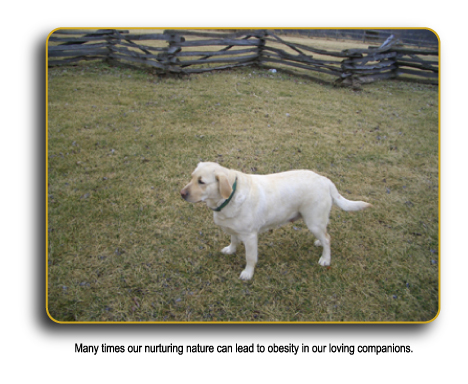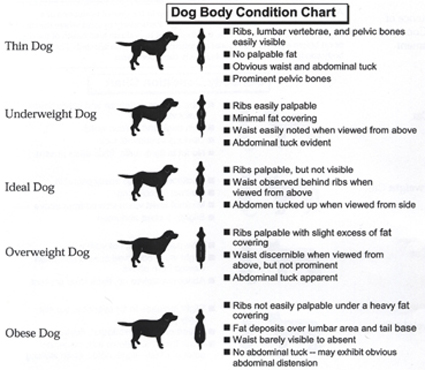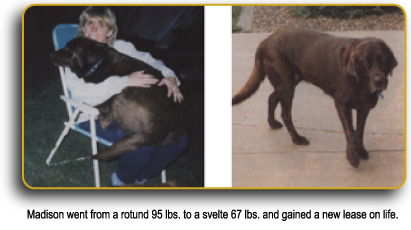


Christmas Store
The holidays are just around the corner so now is the time to fetch the finest gifts for the Labrador Lover on your Christmas list. We have over 100 gifts $50.00 and under. Visit our Christmas Store.
For the Lab
Bedding
Coats
Collars and Leads
Dog Bowls
Feeding Stations
Spa and Grooming
Toys and Treats
Travel and Accessories
For the Lab Lover
Apparel
Cards and Giftwrap
Fine Accessories
Gifts and All Occasions
Jewelry
Kids Only
For the Lab Home
Artwork
Books
Garden and Outdoor
Home Furnishings
Kitchen Accessories
Pillows, Throws, and Rugs
Gift ServicesGift Boxes
Gift Certificates
Trimming the Fat

The Reality
According to a recently released report by the National Academy of Sciences’ National Research Council, one out of every four pets weighs too much. Other studies have shown that this percentage in dogs is higher, revealing that up to 50 percent of all dogs in America are obese. Yet many dog owners are in denial when it comes to their pet’s weight. The fact is “we are facing an epidemic of canine obesity,” according to Dr. Nancy Peters, a veterinarian who participated in a recent weight-management study.
Obese dogs run the same health risks humans do. Veterinarians see heart ailments and high blood pressure in overweight dogs just as physicians see them in overweight people. Overweight dogs frequently have diabetes, as well as arthritis and other skeletal issues such as hip dysplasia and knee problems. In addition, too much weight can lead to compromised immune function, leaving our Labs more prone to infectious diseases.
It is important to note that dogs don’t have to be obese to suffer from an array of weight-related ailments, including cancer. The report suggests the risks to dogs begin with a moderate weight gain at a very early age. For dog owners the message is clear, we have to cut back on food and high-caloric treats for our Labs-or run the risk that our loved one will develop a debilitating illness.
Recent Study Proves Slim Dogs Live Longer Healthier Lives
Last year the Purina Pet Institute completed a 14-year study proving that slimmer dogs live longer. The Purina Life Span Study showed that not only did the lean dogs live longer, they lived better, healthier lives. The study showed a direct correlation between canine obesity and cellular damage. According to Dan Christian, DVM, Executive Director of the Purina Pet Institute, “The increased intake of calories affects dogs on a cellular level. Increased glucose levels can harm the body.”
The Study
Scientists at Purina PetCare conducted a 14-year study of 24 pairs of Labrador Retriever puppies. Half of the pairs ate 25 percent less of the same food as the other partner’s rations. When the dogs turned 9, the team checked the dogs for signs of chronic diseases like diabetes. The lean-fed Labs had the ideal body condition, with abdomen tucked in and ribs prominent. Their well-fed partners ranged from slightly chubby to obese (15 to 20 percent over ideal weight.) Many in the well-fed group had already developed a mild form of diabetes.
After all 48 Labrador Retrievers in the diet study had died of old age, research collaborators (at the veterinary colleges at Cornell University, University of Pennsylvania, University of Illinois, and Michigan State) reviewed the records.
Not surprisingly, the trimmer Labs lived longer, an average of 13.5 years, while the others died at 11.2 years. According to the scientists, most noteworthy was the decreased incidence of canine hip dysplasia (CHD). Even among dogs genetically predisposed to CHD, there was significantly less hip dysplasia in calorie-restricted dogs. “It was dramatic. In the control group (the well-fed Labs), 16 of 24 had hip dysplasia by two years of age. Of the 24 dogs in the restricted diet group, only eight had hip dysplasia and 16 were normal,” said George Lust, a Cornell professor of Physiological Chemistry.
The leaner Labs also displayed fewer early-onset signs of aging (such as graying muzzles & impaired mobility) plus they exhibited fewer health problems like osteoarthritis. Gail Smith, Professor of Orthopedic Surgery at the University of Pennsylvania, addressed the canine implications, “This study should reinforce for dog owners the importance of keeping their dogs lean, with palpable ribs and an obvious waistline,” she said. “Avoid giving dogs too many high-calorie treats and consider a brand of balanced dog food formulated to be low in caloric content while providing a sense of satiety.”
“Labs are genetically predisposed to putting on a few extra pounds as they become older and more sedentary. The good news is, it’s never too late for any dog to benefit from a restricted diet,” stated Purina’s Anne McCarthy, D.V.M.
How Can I Tell If My Lab Is Overweight?

Charts and tables might give you a general idea of your Lab’s recommended weight range. For instance, the AKC lists appropriate weight ranges for Labrador Retriever dogs and bitches in working condition: dogs 65 to 80 pounds; bitches 55 to 70 pounds. However, as in people, some animals are big-boned and some are fine-boned, so just checking the weight of an animal can generally not give us enough information to make a determination. For example, one Labrador Retriever may be in fine shape at 85 pounds, whereas another could be overweight at 75 pounds. Additionally if you have a Lab-mix, weight charts may be of no help at all.
Most veterinarians advocate using a hands-on approach to assess a dog’s body condition:
-
First, run your hands along the rib cage firmly but without too much pressure. You should be able to feel each of your Lab’s ribs and the space between them. There should be a slight amount of fat over them, but each rib should be distinct. If you can see the ribs, the pet is too thin.
-
Next, look at your Lab from the side. Does the stomach tuck up slightly behind the ribcage, or does it hang? Overweight animals will have no abdominal tuck.
-
Look at your Lab from above. Does his waist indent and taper, creating an hourglass shape? Or does your Lab look like a barrel? A healthy dog will have a waist when viewed from above.
If any of these checks are absent, your Lab maybe slightly overweight. If all are missing, and if you notice fleshy deposits over the chest, spine and base of the tail, your Lab is obese.
What You Can Do
If this is the case and you feel that your Lab is overweight, consult your veterinarian to determine if there are any other medical problems before putting your pooch on a diet.
Your veterinarian can suggest the best weight reduction program for your pet based on his medical history.
Some veterinarians recommend high-protein, high quality meals in smaller portions versus diet foods, while others believe that low-calorie, high-density foods will help the dog feel fuller faster. Ask your veterinarian for the best strategy for your Lab and be sure to follow the exact amount prescribed. In addition, make sure everyone in the family including children knows how much and when your dog should eat.
In general, a good goal would be to have your Lab lose between 0.5-1.0% of his body weight per week or a 10 percent weight loss overall. For example if you have a 100-pound dog, a 1-percent weight loss would be 1 pound per week. A weight loss of 2% or more per week can cause more harm than good. Studies show that rapid weight loss can increase a loss of lean body mass, which in turn can contribute to weight regain. Lean body mass burns energy at far higher levels than fat mass.
If your dog is obese, introduce exercise slowly and pace yourself. Ohio State’s obesity-therapy guidelines suggest setting a goal to increase the pet’s activity by 1 minute a day until the goal of 10 minutes a day is reached. Once that level is attained, the duration can again be slowly increased. Regular moderate exercise is not only helpful in maintaining an ideal weight, but also in building muscle mass to help take the strain off the hip joints. Non-concussive forms of exercise, such as swimming can be most beneficial.
In Summary
Even though Labs are predisposed to pack on the pounds, the simple truth is that we are the ones to blame. Simply put, they take in more calories than they burn. Feeding over-large portions and not providing enough exercise are the biggest culprits. “They’re children in some cases, and that’s the reason owners indulge them, but not necessarily to the good of the pet,” says James Morris, Ph.D., one author of the Nutritional Requirements of Cats and Dogs report. Slight behavioral changes on our part can dramatically increase the quality and quantity of our pet’s lives. And who wouldn’t want to add two more years to the life of your Lab?
Success Story

Lisa Winkleman of Colorado Springs, CO was able to help Madison, pictured here at 6 years old, to lose 28 pounds. When asked how she did it, Lisa stated, “We made sure she didn’t get any table scrapes and cut down on her treats. My husband also took her running with him. It was a slow process that took approximately six months for Madison to shed her excess weight. Originally, she received smaller portions of her regular adult food, but it was later when Madison was switched to a diet food that she started showing the improved results.”
Madison is 9 ½ years old now and has no signs of arthritis or hip dysplasia. She runs about 3 to 4 times a week with Lisa’s husband Scott, and loves it. Madison shares her house with 8 other dogs, including three Labs and several Pugs whom the Winklemans foster through Colorado Pug Rescue.
Would love to hear from any other success stories of trimming the fat!
 Can You Spot The Holiday Hazards?
Can You Spot The Holiday Hazards?It’s easy for pets, especially Labradors, to get into trouble during the holidays. You may get so busy that you lose track of what is going on with your dog.
Click here to learn more about: "Can You Spot The Holiday Hazards?"

Would you like to see your Lab pictured here? Send us images of your Lab and we may include them on our Home Page!
Labrador Links
The Verstaile Lab
History of the Lab
Advice
Travel
Featured Labs
Featured Artists
.jpg)

